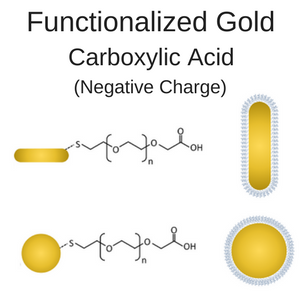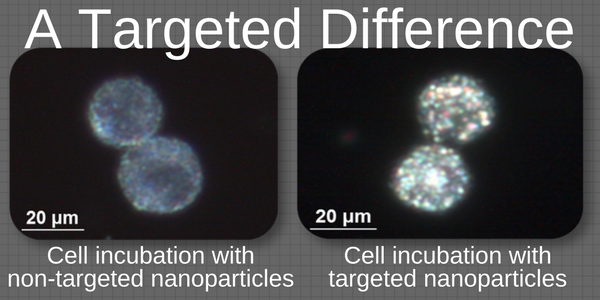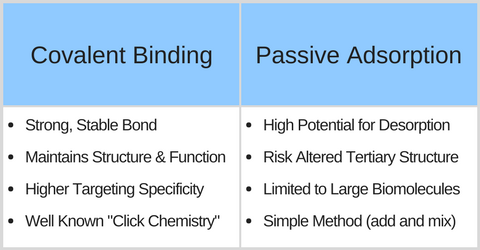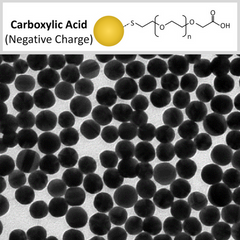Gold Nanoparticles - Carboxylic Acid Functionalized
 Functionalized gold nanoparticles offer the promise of innovative research at the molecular level. Gold nanoparticles (AuNPs) are ideal tools for a wide range of biomolecular applications, including: photoablation, diagnostic imaging, bio-sensing, assays, and radiosensitization among others. The utility of gold nanoparticles across applications relies on an ability to selectively target specific tissues, biomolecules, or cell types. With an easily modified surface that can be selectivity geared towards application specific targets, carboxyl (COOH) functionalized gold nanoparticles give researchers the power to maximize the utility of AuNPs.1 Covalent conjugation is achievable through reaction between the negatively charged carboxylic acid gold nanoparticles to positively charged primary amines. Primary amines can be found at the N-terminus of polypeptide chains and in the side group of the amino acid lysene offering a multitude of choices for conjugation. Application-specific selectivity with carboxyl gold nanoparticles is commonly achieved with conjugation of:
Functionalized gold nanoparticles offer the promise of innovative research at the molecular level. Gold nanoparticles (AuNPs) are ideal tools for a wide range of biomolecular applications, including: photoablation, diagnostic imaging, bio-sensing, assays, and radiosensitization among others. The utility of gold nanoparticles across applications relies on an ability to selectively target specific tissues, biomolecules, or cell types. With an easily modified surface that can be selectivity geared towards application specific targets, carboxyl (COOH) functionalized gold nanoparticles give researchers the power to maximize the utility of AuNPs.1 Covalent conjugation is achievable through reaction between the negatively charged carboxylic acid gold nanoparticles to positively charged primary amines. Primary amines can be found at the N-terminus of polypeptide chains and in the side group of the amino acid lysene offering a multitude of choices for conjugation. Application-specific selectivity with carboxyl gold nanoparticles is commonly achieved with conjugation of:
- antibodies/proteins
- peptides
- and other macromolecules2,3

Superior Binding of Ligands:
When attaching biomolecules to the surface of gold nanoparticles there are 2 primary methods: Passive Adsorption and Covalent Binding. Carboxylic acid functionalized gold nanoparticles allow for selective conjugation via the more stable covalent linkage.

Learn more about conjugating biomolecules to COOH funcationalized gold nanoparticles by clicking here: Attaching Ligands to Carboxyl Functionalized Gold Nanoparticles

Functional Nanoparticles with PEG Spacer:
COOH gold nanoparticles use thiolated polyethylene glycol (PEG-SH) with a carboxyl termination to achieve functionalization. For nanospheres 5 kDA PEG is used, for nanorods 10 kDA PEG is standard.
Advantage of PEG in functionalized gold nanoparticles:
PEGylating gold nanoparticles decreases nonspecific interactions and increases biocompatibility due to the hydrophilic nature of PEG.
PEG size can be varied for custom needs for additional functionality.
(Contact us about custom PEG variations)
Comparison to non-functionalized Gold Nanoparticles:
Carboxylated gold nanoparticles are an ideal and cost-effective means to bind ligands to gold.
- Citrate or CTAB stabilized gold nanoparticles are stable for years and are easily reactive. However, they cannot be concentrated without irreversible aggregation, and most modifications involve weaker adsorption interactions.4,6
- -COOH functionalized nanoparticles are highly stabilized and can be concentrated while facilitating stronger covalent binding.
- Ligand binding orientation can be controlled to maximize functionality.5
AuNPs with carboxyl functionalized surfaces are improving many applications. For example:
1) Carboxyl AuNPs with improved cancer targeting are enhancing both diagnosis and therapy.
2) Functionalized gold nanoparticles make ultra-sensitive sensors for many molecules from biomarkers to environmental factors.
3) Therapeutic DNA/RNA delivery can be achieved with functionalized gold nanoparticles.6
NanoHybrids Difference:
NanoHybrids pairs the functionality of carboxyl-terminated nanoparticles with industry-leading production and reproducibility. By maintaining the lowest batch-to-batch variability of source gold nanoparticles and methodical characterization, NanoHybrids strives to eliminate any experimental discrepancies due to nanoparticle size, uniformity, or surface area available to conjugation.
Carboxylic Acid Functionalized AuNPs are available from NanoHybrids in both NanoSpheres and NanoRods of various sizes. Visit the product pages for more information about individual products and technical specifications.
Click Products to Browse Carboxyl Functionalized Gold Nanoparticles
Sources:
[1] Jazayeri, Mir Hadi, et al. "Various methods of gold nanoparticles (GNPs) conjugation to antibodies." Sensing and Bio-Sensing Research 9 (2016): 17-22.
[2] R.K. DeLong, C.M. Reynolds, Y. Malcolm, A. Schaeffer, T. Severs, A. Wanekaya “Functionalized gold nanoparticles for the binding, stabilization, and delivery of therapeutic DNA, RNA, and other biological macromolecules” Nanotechnol. Sci. Appl., 3 (2010), p. 53
[3] J. Chen, I.R. Corbin, H. Li, W. Cao, J.D. Glickson, G. Zheng “Ligand conjugated low-density lipoprotein nanoparticles for enhanced optical cancer imaging in vivo” J. Am. Chem. Soc., 129 (18) (2007), pp. 5798–5799
[4] R.-A. Sperling, W. Parak “Surface modification, functionalization and bioconjugation of colloidal inorganic nanoparticles” Philos. Trans. R. Soc. Lond. A Math. Phys. Eng. Sci., 368 (1915) (2010), pp. 1333–1383.
[5] S. Kumar, J. Aaron, K. Sokolov “Directional conjugation of antibodies to nanoparticles for synthesis of multiplexed optical contrast agents with both delivery and targeting moieties.” Nat. Protoc., 3 (2) (2008), pp. 314–320
[6] DeLong, Robert K., et al. "Functionalized gold nanoparticles for the binding, stabilization, and delivery of therapeutic DNA, RNA, and other biological macromolecules." Nanotechnol Sci Appl 3.1 (2010): 53-63.


